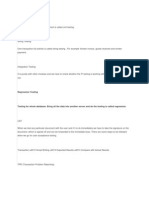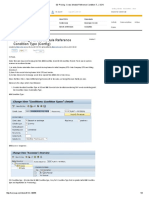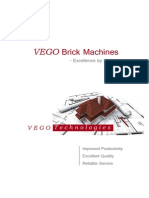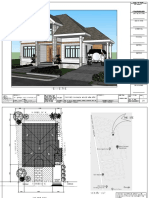Linear Algebra
Uploaded by
spsarath417Linear Algebra
Uploaded by
spsarath417LINEAR ALGEBRA AND CALCULUS CATEGORY L T P CREDIT Year of
MAT Introduction
101 BSC 3 1 0 4 2019
Preamble: This course introduces students to some basic mathematical ideas and tools which are at
the core of any engineering course. A brief course in Linear Algebra familiarises students with some
basic techniques in matrix theory which are essential for analysing linear systems. The calculus of
functions of one or more variables taught in this course are useful in modelling and analysing
physical phenomena involving continuous change of variables or parameters and have applications
across all branches of engineering.
Prerequisite: A basic course in one-variable calculus and matrix theory.
Course Outcomes: After the completion of the course the student will be able to
CO 1 solve systems of linear equations, diagonalize matrices and characterise quadratic forms
CO 2 compute the partial and total derivatives and maxima and minima of multivariable functions
CO 3 compute multiple integrals and apply them to find areas and volumes of geometrical shapes,
mass and centre of gravity of plane laminas
CO 4 perform various tests to determine whether a given series is convergent, absolutely
convergent or conditionally convergent
CO 5 determine the Taylor and Fourier series expansion of functions and learn their applications.
Mapping of course outcomes with program outcomes
PO PO 2 PO 3 PO 4 PO 5 PO 6 PO PO 8 PO 9 PO 10 PO 11 PO 12
1 7
CO 1 3 3 3 3 2 1 1 2 2
CO 2 3 3 3 3 2 1 1 2 2
CO 3 3 3 3 3 2 1 1 2 2
CO 4 3 2 3 2 1 1 1 2 2
CO 5 3 3 3 3 2 1 1 2 2
Assessment Pattern
Bloom’s Category Continuous Assessment Tests End Semester
Test 1 Test 2 Examination
(Marks) (Marks) (Marks)
Remember 10 10 20
Understand 20 20 40
Apply 20 20 40
Analyse
Evaluate
Create
Downloaded from Ktunotes.in
Mark distribution
Total Marks CIE ESE ESE Duration
marks marks
150 50 100 3 hours
Continuous Internal Evaluation Pattern:
Attendance : 10 marks
Continuous Assessment Test (2 numbers) : 25 marks
Assignment/Quiz/Course project : 15 marks
Assignments: Assignment should include specific problems highlighting the applications of the
methods introduced in this course in science and engineering.
End Semester Examination Pattern: There will be two parts; Part A and Part B. Part A contain 10
questions with 2 questions from each module, having 3 marks for each question. Students should
answer all questions. Part B contains 2 questions from each module of which student should answer
any one. Each question can have maximum 2 sub-divisions and carry 14 marks.
Course Level Assessment Questions
Course Outcome 1 (CO1): Solve systems of linear equations, diagonalize matrices and characterise
quadratic forms
𝑥
1. A is a real matrix of order 3 × 3and 𝑋 = 𝑦 . What can you say about the solution of 𝐴𝑋 =
𝑧
0if rank of A is 1? 2 ?3?
3 0 2
2. Given𝐴 = 0 2 0 , find an orthogonal matrix 𝑃that diagonalizes A.
−2 0 0
3. Find out what type of conic section the following quadratic form represents
17𝑥 − 30𝑥 𝑥 + 17𝑥 = 128
−2 2 −3
4. The matrix 𝐴 = 2 1 −6 has an eigen value5 with corresponding Eigen vector𝑋 =
−1 −2 0
1
2 . Find 𝐴 𝑋
−1
Course Outcome 2 (CO2): compute the partial and total derivatives and maxima and minima of
multivariable functions
1. Find the slope of the surface 𝑧 = 𝑥 𝑦 + 5𝑦 in the x-direction at the point (1,-2)
Downloaded from Ktunotes.in
2. Given the function 𝑤 = 𝑥𝑦 + 𝑧, use chain rule to find the instantaneous rate of change of
𝑤at each point along the curve 𝑥 = 𝑐𝑜𝑠𝑡, 𝑦 = 𝑠𝑖𝑛𝑡, 𝑧 = 𝑡
3. Determine the dimension of rectangular box open at the top , having a volume 32 cubic ft
and requiring the least amount of material for it’s construction.
Course Outcome 3(CO3): compute multiple integrals and apply them to find areas and volumes of
geometrical shapes, mass and centre of gravity of plane laminas.
1. Evaluate ∬ (𝑥 + 2𝑦) 𝐷𝐴where D is the region bounded by the parabolas 𝑦 = 2𝑥 and
𝑦 = 1+𝑥
2. Explain how you would find the volume under the surface 𝑧 = 𝑓(𝑥, 𝑦)and over a specific
region 𝐷in the 𝑥𝑦plane using (i) double integral (ii) triple integral?
3. Find the mass and centre of gravity of a triangular lamina with vertices (0,0), (2,1), (0,3) if
the density function is 𝑓(𝑥, 𝑦) = 𝑥 + 𝑦
4. Use spherical coordinates to evaluate ∭ (𝑥 + 𝑦 + 𝑧 ) 𝑑𝑉where B is the unit ball
defined by 𝐵 = {(𝑥, 𝑦, 𝑧): 𝑥 + 𝑦 + 𝑧 ≤ 1}
Course Outcome 4 (CO4): perform various tests to determine whether a given series is convergent,
absolutely convergent or conditionally convergent.
1. What is the difference between a sequence and a series and when do you say that they are
convergent? Divergent?
∞
2. Determine whether the series ∑ converges or diverges.
∞( )
3. Is the series ∑ convergent? Absolutely convergent? Conditionally convergent?
Course Outcome 5 (CO5): determine the Taylor and Fourier series expansion of functions and learn
their applications.
1. Assuming the possibility of expansion find the Maclaurin series expansion of
𝑓(𝑥) = (1 + 𝑥) for|𝑥| < 1where 𝑘is any real number. What happens if 𝑘is a positive
integer?
2. Use Maclaurin series of 𝑙𝑛(1 + 𝑥), −1 < 𝑥 ≤ 1to find an approximate value of𝑙𝑛2.
3. Find the Fourier series of the function𝑓(𝑥) = 𝑥 , −2 ≤ 𝑥 < 2, 𝑓(𝑥 + 4) = 𝑓(𝑥). Hence
using Parseval’s identity prove that 1 + + + … =
4. Expand the function 𝑓(𝑥) = 𝑥 (0 < 𝑥 < 1⁄2) into a (i) Fourier sine series (ii) Fourier cosine
series.
Downloaded from Ktunotes.in
Model Question paper
QP CODE: PAGES:3
Reg No:______________
Name :______________
APJ ABDUL KALAM TECHNOLOGICAL UNIVERSITY FIRST SEMESTER B.TECH DEGREE EXAMINATION,
MONTH & YEAR
Course Code: MAT 101
Max. Marks: 100 Duration: 3 Hours
LINEAR ALGEBRA AND CALCULUs
(2019-Scheme)
(Common to all branches)
PART A
(Answer all questions, each question carries 3 marks)
1 2 −1
1. Determine the rank of the matrix 𝐴 = −2 −4 2 .
3 6 −3
2 0
2. Write down the eigen values of = . What are the eigen values of 𝑃 𝐴𝑃 where
0 −1
−4 2
𝑃= ?
3 −1
3. Find 𝑓 (1,3) and 𝑓 (1,3) for the function 𝑓(𝑥, 𝑦) = 2𝑥 𝑦 + 2𝑦 + 4𝑥.
4. Show that the function 𝑢(𝑥, 𝑡) = sin (𝑥 − 𝑐𝑡) is a solution of the equation =𝑐
.
5. Use double integral to find the area of the region enclosed between the parabolas 𝑦 = 𝑥
and the line 𝑦 = 2𝑥.
6. Use polar coordinates to evaluate the area of the region bounded by 𝑥 + 𝑦 = 4, the line
𝑦 = 𝑥 and the y axis in the first quadrant
7. Test the convergence of the series ∑∞ .
8. Test the convergence of the alternating series ∑∞ (−1) using Leibnitz test.
9. Find the Taylor series expansion of 𝑠𝑖𝑛𝜋𝑥about𝑥 = .
10. Find the values to which the Fourier series of
𝑓(𝑥) = 𝑥for−𝜋 < 𝑥 < 𝜋, with 𝑓(𝑥 + 2𝜋) = 𝑓(𝑥) converges (10x3=30)
Downloaded from Ktunotes.in
PART B
(Answer one full question from each module, each question carries 14 marks)
Module -I
11. (a) Solve the following system of equations
𝑦 + 𝑧 − 2𝑤 = 0
2𝑥 − 3𝑦 − 3𝑧 + 6𝑤 = 2
4𝑥 + 𝑦 + 𝑧 − 2𝑤 = 4
−2 2 −3
(b) Find the eigen values and eigen vectors of the matrix 2 1 −6
−1 −2 0
−1 2 −2
12. (a) Diagonalize the matrix 2 4 1
2 1 4
(b) What kind of conic section the quadratic form3𝑥 + 22𝑥 𝑥 + 3𝑥 = 0 represents?
Transform it to principal axes.
Module - II
13. (a) Find the local linear approximation to 𝑓(𝑥, 𝑦) = 𝑥 + 𝑦 at the point (3, 4).Use it to
approximate 𝑓(3.04,3.98)
(b) Let 𝑤 = 𝑥 + 𝑦 + 𝑧 , 𝑥 = 𝑐𝑜𝑠𝜃, 𝑦 = 𝑠𝑖𝑛𝜃, 𝑧 = 𝑡𝑎𝑛𝜃. Use chain rule to find when
𝜃= .
14. (a) Let 𝑧 = 𝑓(𝑥, 𝑦) where 𝑥 = 𝑟𝑐𝑜𝑠𝜃, 𝑦 = 𝑟𝑠𝑖𝑛𝜃, prove that
+ = + .
(b) Locate all relative maxima, relative minima and saddle points
𝑓(𝑥, 𝑦) = 𝑥𝑦 + + (𝑎 ≠ 0, 𝑏 ≠ 0).
Module - III
15. (a) Evaluate∬ (2𝑥 𝑦 + 9𝑦 ) 𝑑𝑥𝑑𝑦 where D is the region bounded by 𝑦 = 𝑥 and 𝑦 = 2√𝑥
(b) Evaluate ∫ ∫ 𝑒 𝑑𝑥𝑑𝑦 changing the order of integration.
√
16. (a) Find the volume of the solid bounded by the cylinder 𝑥 + 𝑦 = 4 and the planes
𝑦 + 𝑧 = 4 and 𝑧 = 0..
(b) Evaluate ∭ 1 − 𝑥 − 𝑦 − 𝑧 𝑑𝑥𝑑𝑦𝑑𝑧, taken throughout the volume of
the sphere 𝑥 + 𝑦 + 𝑧 = 1, by transforming to spherical polar coordinates
Module - IV
17. (a) Test the convergence of the series
(i) ∑∞ (ii) ∑∞
!
( )!
(b) Determine the convergence or divergence of the series ∑∞ (−1)
( )!
18. (a) Check whether the series ∑∞ (−1) ( )!
is absolutely convergent, conditionally
convergent or divergent.
Downloaded from Ktunotes.in
. . . . . .
(b) Test the convergence of the series 1 + .
+ . .
+ . . .
+⋯
Module - V
19. (a) Obtain the Fourier series of for𝑓(𝑥) = 𝑒 , in the interval 0 < 𝑥 < 2𝜋.with 𝑓 𝑥 +
( )
2𝜋 = 𝑓(𝑥). Hence deduce the value of∑∞ .
𝑖𝑓 0 < 𝑥 <
(b) Find the half range sine series of 𝑓(𝑥) = ( )
𝑖𝑓 <𝑥<𝐿
20. (a)Expand (1 + 𝑥) .as a Taylor series about 𝑥 = 0and state the region of convergence of
the series.
(b) Find the Fourier series for 𝑓(𝑥) = 𝑥 in the interval −𝜋 < 𝑥 < 𝜋
with 𝑓(𝑥 + 2𝜋) = 𝑓(𝑥).Hence show that + + +⋯ = . (14X5=70)
Syllabus
Module 1 (Linear algebra)
(Text 2: Relevant topics from sections 7.3, 7.4, 7.5, 8.1,8.3,8.4)
Systems of linear equations, Solution by Gauss elimination, row echelon form and rank of a matrix,
fundamental theorem for linear systems (homogeneous and non-homogeneous, without proof),
Eigen values and eigen vectors. Diagonaliztion of matrices, orthogonal transformation, quadratic
forms and their canonical forms.
Module 2 (multivariable calculus-Differentiation)
(Text 1: Relevant topics from sections 13.3, 13.4, 13.5, 13.8)
Concept of limit and continuity of functions of two variables, partial derivatives, Differentials, Local
Linear approximations, chain rule, total derivative, Relative maxima and minima, Absolute maxima
and minima on closed and bounded set.
Module 3(multivariable calculus-Integration)
(Text 1: Relevant topics from sections 14.1, 14.2, 14.3, 14.5, 14.6, 14.8)
Double integrals (Cartesian), reversing the order of integration, Change of coordinates (Cartesian to
polar), finding areas and volume using double integrals, mass and centre of gravity of
inhomogeneous laminas using double integral. Triple integrals, volume calculated as triple integral,
triple integral in cylindrical and spherical coordinates (computations involving spheres, cylinders).
Downloaded from Ktunotes.in
Module 4 (sequences and series)
(Text 1: Relevant topics from sections 9.1, 9.3, 9.4, 9.5, 9.6)
Convergence of sequences and series, convergence of geometric series and p-series(without proof),
test of convergence (comparison, ratio and root tests without proof); Alternating series and Leibnitz
test, absolute and conditional convergence.
Module 5 (Series representation of functions)
(Text 1: Relevant topics from sections 9.8, 9.9. Text 2: Relevant topics from sections 11.1, 11.2,
11.6 )
Taylor series (without proof, assuming the possibility of power series expansion in appropriate
domains), Binomial series and series representation of exponential, trigonometric, logarithmic
functions (without proofs of convergence); Fourier series, Euler formulas, Convergence of Fourier
series (without proof), half range sine and cosine series, Parseval’s theorem (without proof).
Text Books
1. H. Anton, I. Biven,S.Davis, “Calculus”, Wiley, 10th edition, 2015.
2. Erwin Kreyszig, Advanced Engineering Mathematics, 10 thEdition, John Wiley & Sons, 2016.
Reference Books
1. J. Stewart, Essential Calculus, Cengage, 2nd edition, 2017
2. G.B. Thomas and R.L. Finney, Calculus and Analytic geometry, 9 th Edition, Pearson, Reprint,
2002.
3. Peter V. O'Neil, Advanced Engineering Mathematics , Cengage, 7th Edition, 2012
4. Veerarajan T., Engineering Mathematics for first year, Tata McGraw-Hill, New Delhi, 2008.
5. B.S. Grewal, Higher Engineering Mathematics, Khanna Publishers, 36 Edition, 2010.
Course Contents and Lecture Schedule
No Topic No. of Lectures
1 Linear Algebra (10 hours)
1.1 Systems of linear equations, Solution by Gauss elimination 1
1.2 Row echelon form, finding rank from row echelon form, fundamental 3
theorem for linear systems
1.3 Eigen values and eigen vectors 2
1.4 Diagonaliztion of matrices, orthogonal transformation, quadratic forms 4
Downloaded from Ktunotes.in
and their canonical forms.
2 Multivariable calculus-Differentiation (8 hours)
2.1 Concept of limit and continuity of functions of two variables, partial 2
derivatives
2.2 Differentials, Local Linear approximations 2
2.3 Chain rule, total derivative 2
2.4 Maxima and minima 2
3 Multivariable calculus-Integration (10 hours)
3.1 Double integrals (Cartesian)-evaluation 2
3.2 Change of order of integration in double integrals, change of coordinates 2
(Cartesian to polar),
3.3 Finding areas and volumes, mass and centre of gravity of plane laminas 3
3.4 Triple integrals 3
4 Sequences and series (8 hours)
4.1 Convergence of sequences and series, geometric and p-series 2
4.2 Test of convergence( comparison, ratio and root ) 4
4.3 Alternating series and Leibnitz test, absolute and conditional convergence 2
5 Series representation of functions (9 hours)
5.1 Taylor series, Binomial series and series representation of exponential, 3
trigonometric, logarithmic functions;
5.2 Fourier series, Euler formulas, Convergence of Fourier series(Dirichlet’s 3
conditions)
5.3 Half range sine and cosine series, Parseval’s theorem. 3
Downloaded from Ktunotes.in
You might also like
- Syllabus & Plane - Summer 2022 - Statics - PHM 031No ratings yetSyllabus & Plane - Summer 2022 - Statics - PHM 0312 pages
- Measuring The Performance of ERP SoftwareNo ratings yetMeasuring The Performance of ERP Software12 pages
- Types of Tests Unit Testing: System TestNo ratings yetTypes of Tests Unit Testing: System Test4 pages
- 9th - Introduction To Euclids Geometry Test Paper-4No ratings yet9th - Introduction To Euclids Geometry Test Paper-42 pages
- Sap Fico - Interview Questions: Types of Servers in SapNo ratings yetSap Fico - Interview Questions: Types of Servers in Sap10 pages
- 21 Best, Easy Memorization Techniques For StudentsNo ratings yet21 Best, Easy Memorization Techniques For Students1 page
- How To Create Sales Document Type in SAPNo ratings yetHow To Create Sales Document Type in SAP10 pages
- 0018 SAP MDM With S4 HANA Syllabus UCPL TechnologiesNo ratings yet0018 SAP MDM With S4 HANA Syllabus UCPL Technologies6 pages
- Sap Advanced Available To Promise - Features and FunctionalitiesNo ratings yetSap Advanced Available To Promise - Features and Functionalities10 pages
- CBSE 10th Maths - MCQ On Chapter 15probability With Answers PDFNo ratings yetCBSE 10th Maths - MCQ On Chapter 15probability With Answers PDF28 pages
- Production Cutover Activities in SAP MM S4 HANANo ratings yetProduction Cutover Activities in SAP MM S4 HANA2 pages
- SAP Functional Director or SAP Functional Manager or SAP ProjectNo ratings yetSAP Functional Director or SAP Functional Manager or SAP Project8 pages
- Institut Kemahiran MARA Sungai Petani, Kedah: Information SheetNo ratings yetInstitut Kemahiran MARA Sungai Petani, Kedah: Information Sheet6 pages
- Software Testing Is A Process of Verifying and Validating That ANo ratings yetSoftware Testing Is A Process of Verifying and Validating That A61 pages
- SD Pricing - Cross Module Reference Condition T..No ratings yetSD Pricing - Cross Module Reference Condition T..8 pages
- Section A: Sample/Pre-Board Paper 1 Class X Term 1 Exam Nov - Dec 2021 Mathematics (Standard) 041No ratings yetSection A: Sample/Pre-Board Paper 1 Class X Term 1 Exam Nov - Dec 2021 Mathematics (Standard) 0415 pages
- Matrices JEE Main 2021 (July) Chapter-Wise QuestionsNo ratings yetMatrices JEE Main 2021 (July) Chapter-Wise Questions9 pages
- Annual Examination, 2021 Vi - Mathematics Subjective Type Time: 2Hr 10 Min Total Marks: 60No ratings yetAnnual Examination, 2021 Vi - Mathematics Subjective Type Time: 2Hr 10 Min Total Marks: 603 pages
- 10th Samacheer Kalvi Maths All Units Points To RememberNo ratings yet10th Samacheer Kalvi Maths All Units Points To Remember10 pages
- 10 Must Have Skills For Consultants Working in SAP AMS PracticeNo ratings yet10 Must Have Skills For Consultants Working in SAP AMS Practice4 pages
- Participatory Action Research Literature Review100% (1)Participatory Action Research Literature Review7 pages
- Institut de Ciencia de Materials de Barcelona, CSIC Camus de La UAB, 08193 Barcelona, SpainNo ratings yetInstitut de Ciencia de Materials de Barcelona, CSIC Camus de La UAB, 08193 Barcelona, Spain8 pages
- ISIS Multi Stage Thermostat Start/Stop 7 Day Programmable BrochureNo ratings yetISIS Multi Stage Thermostat Start/Stop 7 Day Programmable Brochure2 pages
- Standard Solutions: Innovative Fluid PowerNo ratings yetStandard Solutions: Innovative Fluid Power70 pages
- RD Sharma Solutions For Class 10 Chapter 8 Quadratic Equations PDFNo ratings yetRD Sharma Solutions For Class 10 Chapter 8 Quadratic Equations PDF75 pages
- Oil Company or Service Company - OffshoreNo ratings yetOil Company or Service Company - Offshore11 pages
- Do You Agree or Disagree That A Sense of Competition Motivates Young PeopleNo ratings yetDo You Agree or Disagree That A Sense of Competition Motivates Young People1 page
- Engineering Resume For Internship Example TemplateNo ratings yetEngineering Resume For Internship Example Template2 pages
- IC6501 SCAD MSM by WWW - Learnengineering.inNo ratings yetIC6501 SCAD MSM by WWW - Learnengineering.in223 pages
- Syllabus & Plane - Summer 2022 - Statics - PHM 031Syllabus & Plane - Summer 2022 - Statics - PHM 031
- 9th - Introduction To Euclids Geometry Test Paper-49th - Introduction To Euclids Geometry Test Paper-4
- Sap Fico - Interview Questions: Types of Servers in SapSap Fico - Interview Questions: Types of Servers in Sap
- 21 Best, Easy Memorization Techniques For Students21 Best, Easy Memorization Techniques For Students
- 0018 SAP MDM With S4 HANA Syllabus UCPL Technologies0018 SAP MDM With S4 HANA Syllabus UCPL Technologies
- Sap Advanced Available To Promise - Features and FunctionalitiesSap Advanced Available To Promise - Features and Functionalities
- CBSE 10th Maths - MCQ On Chapter 15probability With Answers PDFCBSE 10th Maths - MCQ On Chapter 15probability With Answers PDF
- SAP Functional Director or SAP Functional Manager or SAP ProjectSAP Functional Director or SAP Functional Manager or SAP Project
- Institut Kemahiran MARA Sungai Petani, Kedah: Information SheetInstitut Kemahiran MARA Sungai Petani, Kedah: Information Sheet
- Software Testing Is A Process of Verifying and Validating That ASoftware Testing Is A Process of Verifying and Validating That A
- Section A: Sample/Pre-Board Paper 1 Class X Term 1 Exam Nov - Dec 2021 Mathematics (Standard) 041Section A: Sample/Pre-Board Paper 1 Class X Term 1 Exam Nov - Dec 2021 Mathematics (Standard) 041
- Matrices JEE Main 2021 (July) Chapter-Wise QuestionsMatrices JEE Main 2021 (July) Chapter-Wise Questions
- Annual Examination, 2021 Vi - Mathematics Subjective Type Time: 2Hr 10 Min Total Marks: 60Annual Examination, 2021 Vi - Mathematics Subjective Type Time: 2Hr 10 Min Total Marks: 60
- 10th Samacheer Kalvi Maths All Units Points To Remember10th Samacheer Kalvi Maths All Units Points To Remember
- 10 Must Have Skills For Consultants Working in SAP AMS Practice10 Must Have Skills For Consultants Working in SAP AMS Practice
- Institut de Ciencia de Materials de Barcelona, CSIC Camus de La UAB, 08193 Barcelona, SpainInstitut de Ciencia de Materials de Barcelona, CSIC Camus de La UAB, 08193 Barcelona, Spain
- ISIS Multi Stage Thermostat Start/Stop 7 Day Programmable BrochureISIS Multi Stage Thermostat Start/Stop 7 Day Programmable Brochure
- RD Sharma Solutions For Class 10 Chapter 8 Quadratic Equations PDFRD Sharma Solutions For Class 10 Chapter 8 Quadratic Equations PDF
- Do You Agree or Disagree That A Sense of Competition Motivates Young PeopleDo You Agree or Disagree That A Sense of Competition Motivates Young People
- Engineering Resume For Internship Example TemplateEngineering Resume For Internship Example Template

























































































